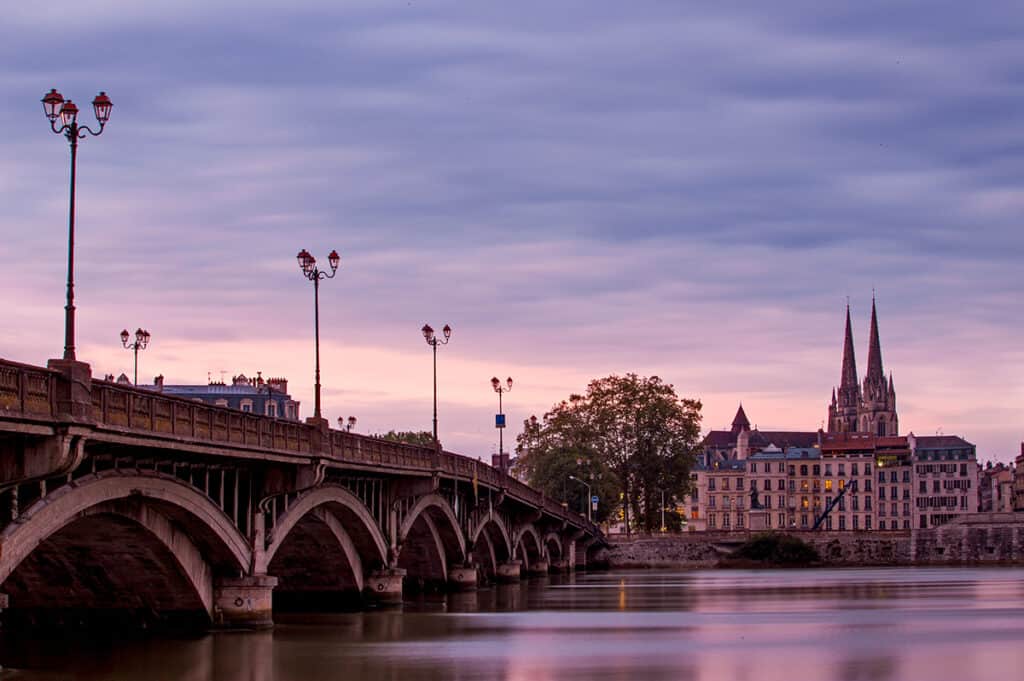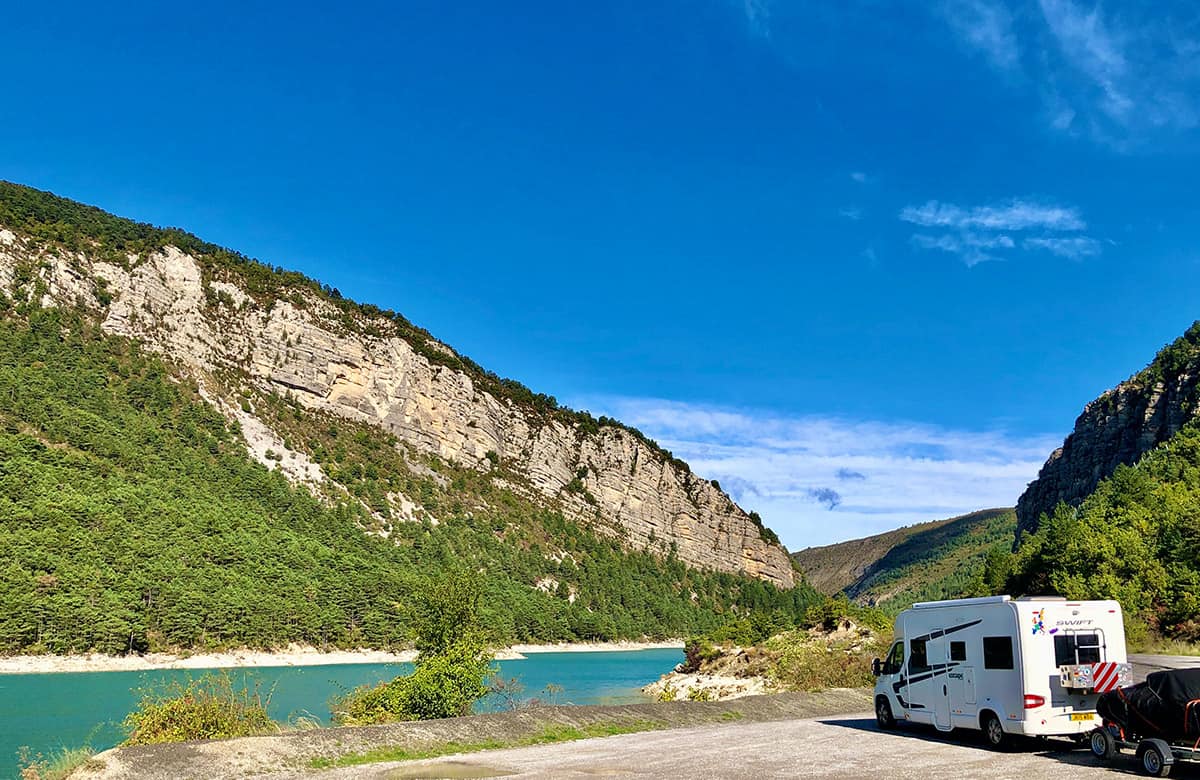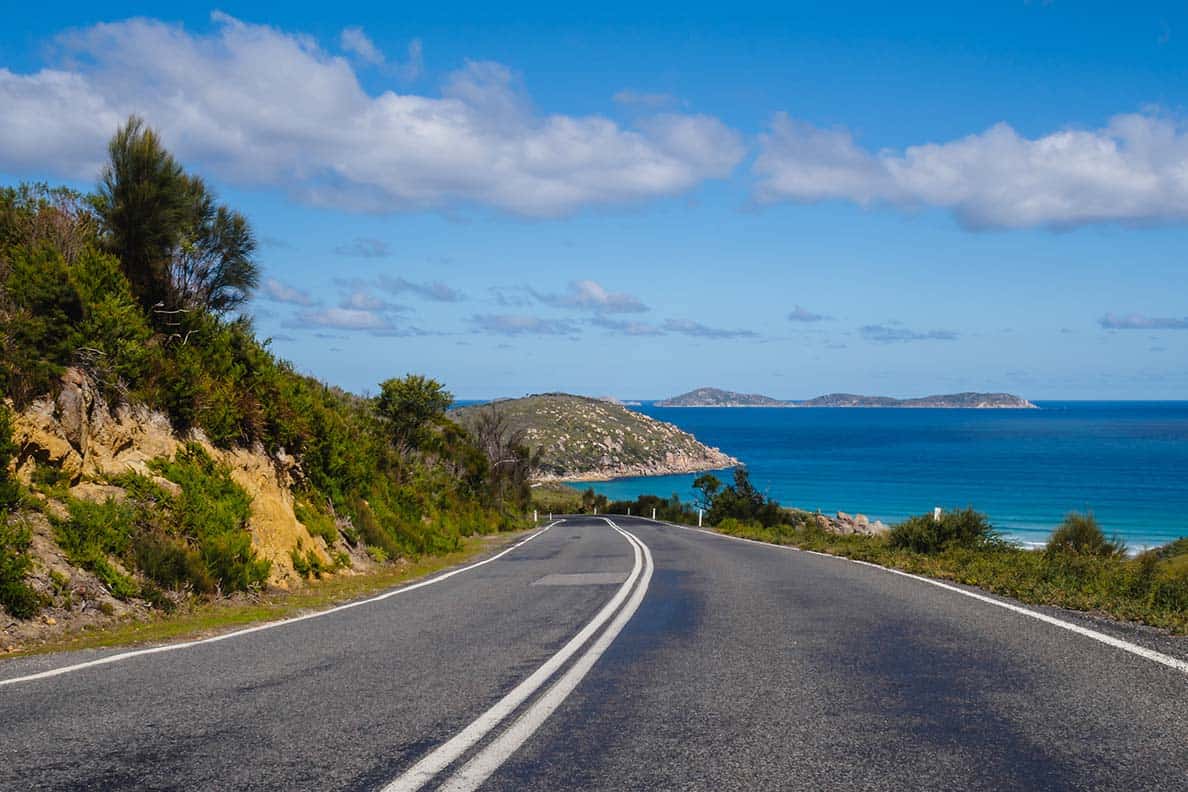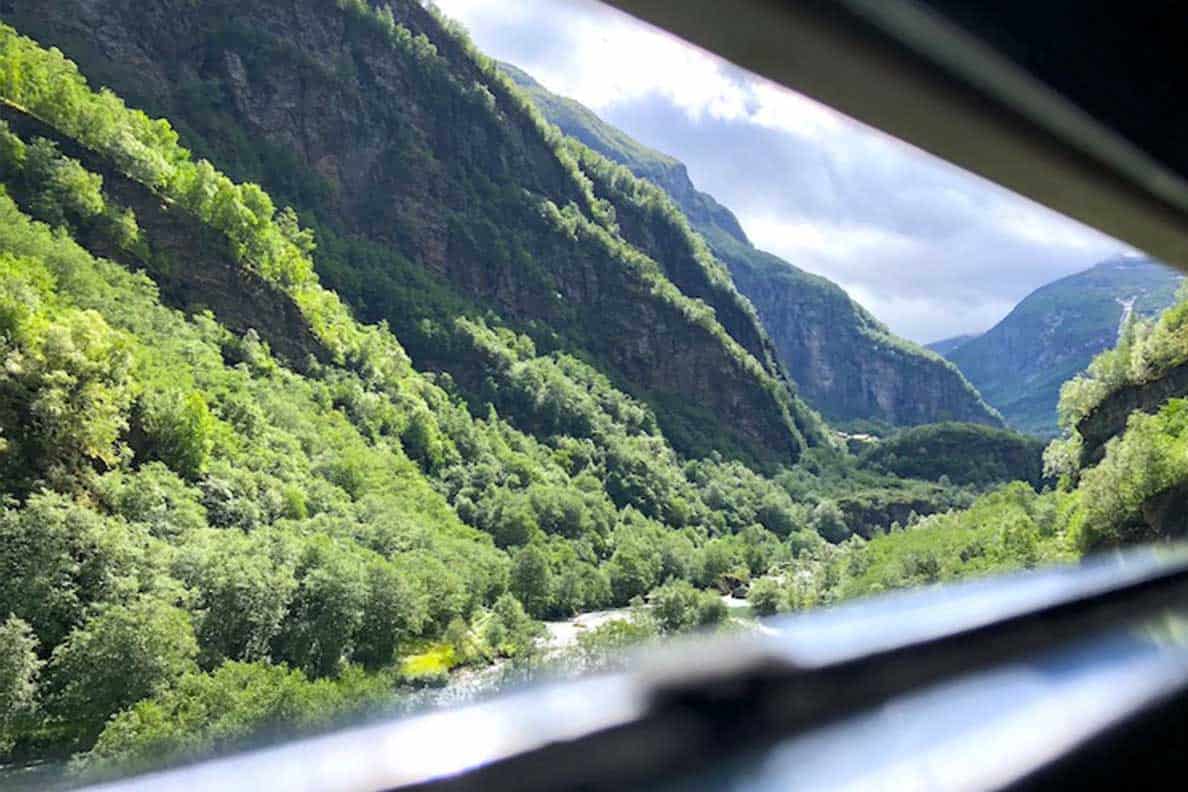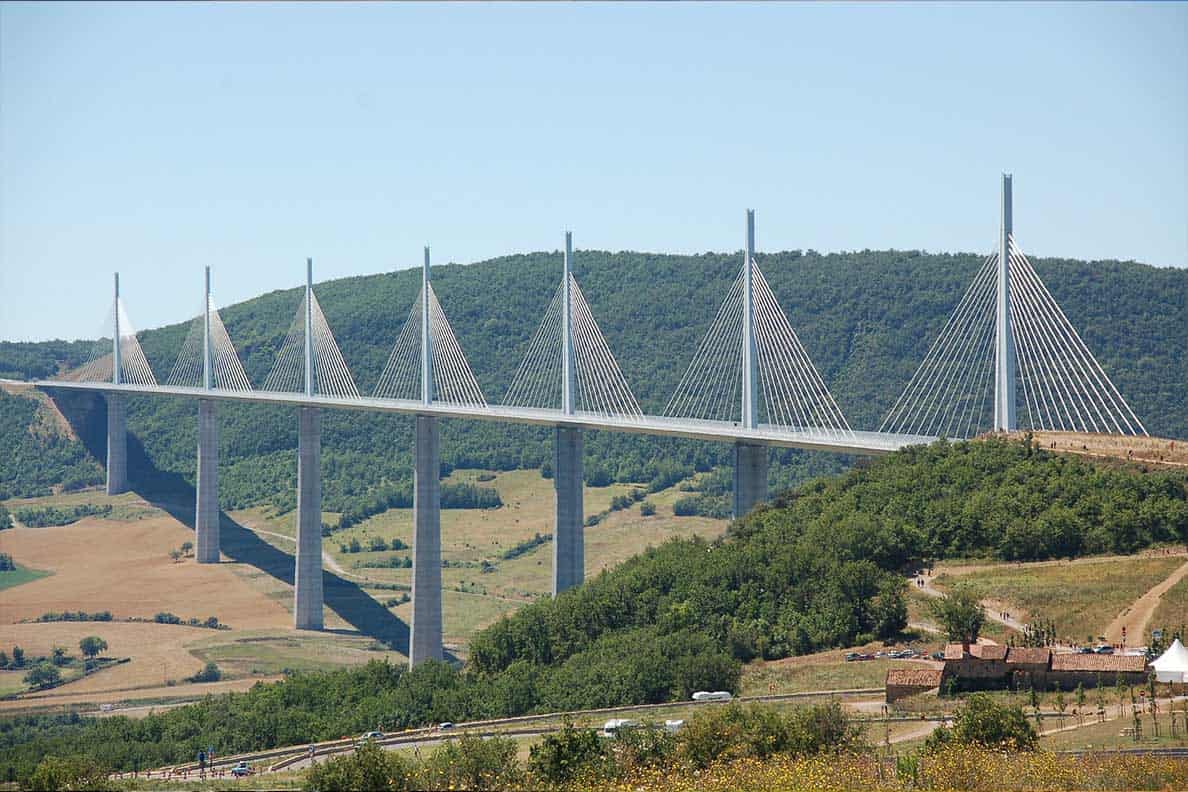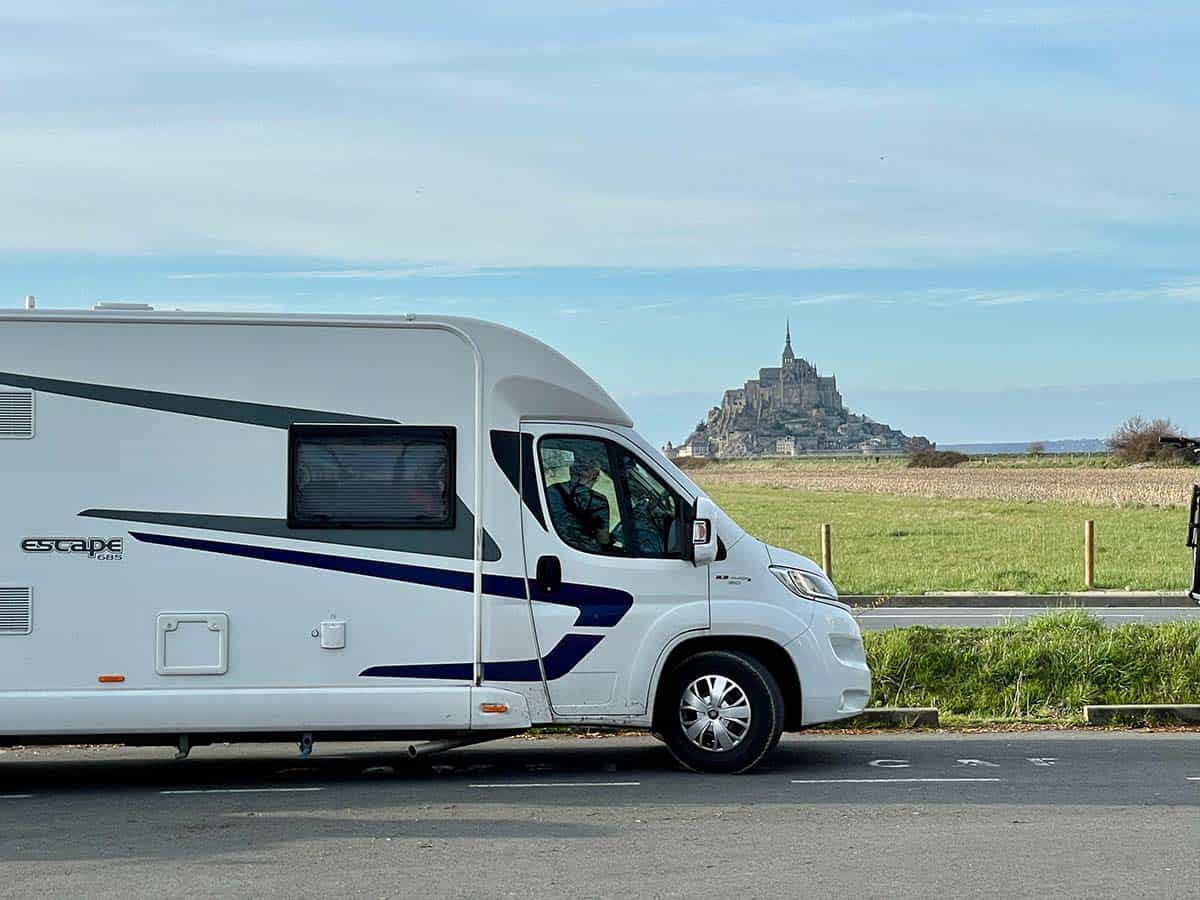France trip- 7 historical places in France (you HAVE to visit!)
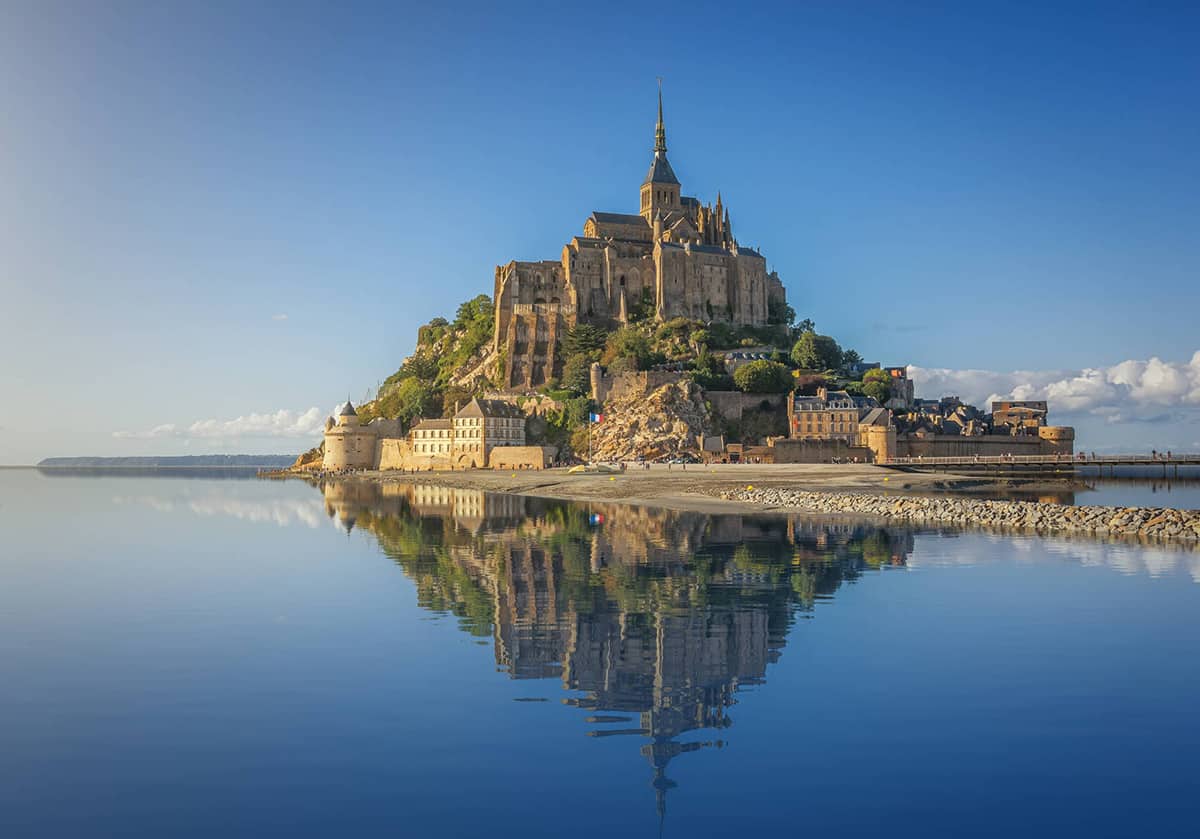
Planning a France trip? Want to experience some of the incredible history and culture of France? No problem- here are 7 of the BEST historical places in France.
We’ve all been there. It’s so easy to get overwhelmed when planning a trip to France. There are SO. MANY. PLACES to visit and so little time.
Heck, my husband and I practically LIVE in France (we spend a lot of time touring France in our Motorhome) – and we still haven’t been everywhere on our list.
So, to help you out (you’re welcome) here are 7 of the most historical places in France that EVERYONE should visit.
Quick disclaimer: There are a huge number of places I could have put onto this list. But me writing a post titled ‘7000 historical places in France everyone should visit’ wouldn’t help you narrow it down. At all.
BUT- if there’s a place you LOVE, with historical significance, I absolutely want to hear about it. Please leave your comment at the bottom of this post so everyone else who’s planning a France trip can benefit from your experience. Thanks for helping out. 🙂
Now, in no particular order (because it’s impossible to choose!) here are some of the most incredible historical places in France. If you just want to see famous cities- here are 10 of the top cities in France (outside of Paris) that you REALLY should check out.
JUMP AHEAD TO...
Planning a trip to France? Grab your FREE road trip planner HERE and start creating your perfect trip
Map of these Historical Places in France
As a reference, here’s a map of the historical sites mentioned in this post, so you can see if any are near where you’re planning to visit.
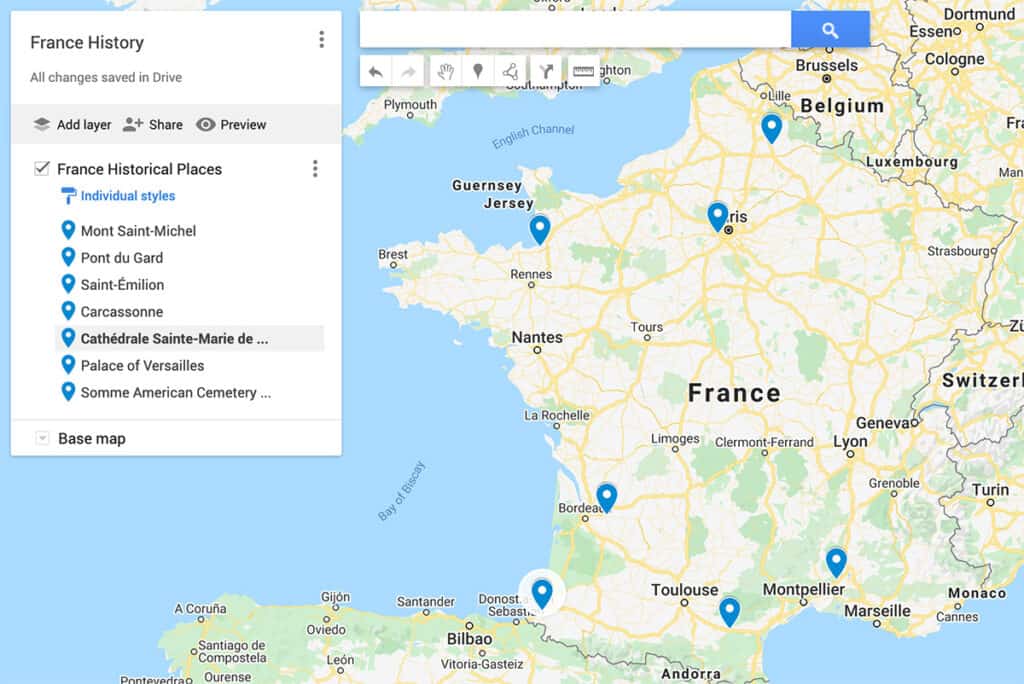
Mont St Michel- one of the most famous & historical places in France
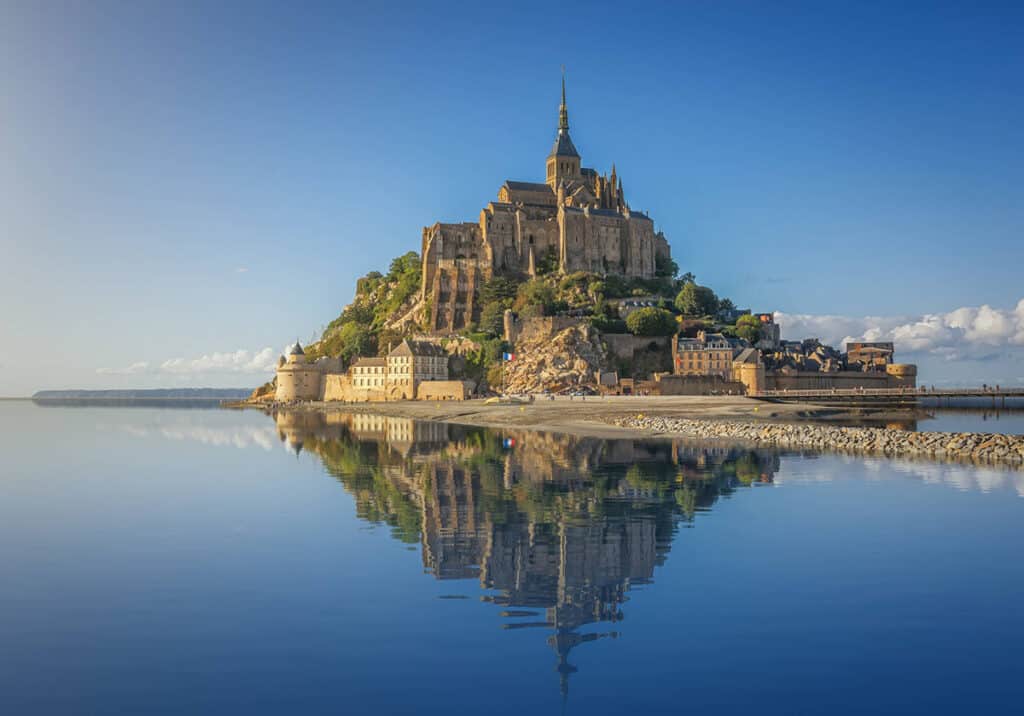
Recommended by Jenna | I Know the Pilot
Mont Saint-Michel rises out of the ocean like some mythical castle, the Medieval buildings and church spire gleaming in the sun. Located roughly one kilometre out from the shore, this famous UNESCO-heritage listed tidal island has experienced its fair share of history and is an incredibly beautiful and unique place to visit.
Why is Mont St Michel a historical place in France?
Originally settled by an Irish hermit, the island has been a working monastery for over a thousand years and is still home to several monks and nuns who occupy the Abbey.
Visitors can also check out the Abbey itself, which does cost 11 euro to visit (and it’s right at the top of the island!). That being said, it is a beautiful example of medieval architecture, including the cloisters, refectory and gardens, and worth the fee. In Summer, the Abbey gardens host a light and sound show in the evenings.
How easy is it to visit Mont St Michel?
Very easy.
Entry to the island is free; however, visitors will need to pay for parking if they have their own car or campervan. There are also public transport options, taxis and even a ferry from Saint-Malo.
The complex is open every day except Christmas Day and New Years Day, from 9:30am – 6pm (and 7pm in Summer). Visitors can walk to the island from the car park, or there are also shuttle buses to take you across. If you’re feeling fancy, opt for a horse-drawn carriage! We recommend getting there early to have a full day of exploring – it’s a great spot to visit all year round, though it can get quite warm in summer (remember – lots of stairs).
The entire island is surrounded by ramparts, which visitors can walk on for amazing views of the surrounding countryside. Made up of cobbled streets and steep staircases, a good pair of shoes is essential to explore the town comfortably!
Where to eat at Mont St Michel
Take a walk through the ancient streets, visiting the many shops or even a museum or two, before stopping for one of the towns famous omelettes and crepes. No visit to Mt St Michel is complete without checking out La Mère Poulard, home to (so they say) ‘the best, fluffiest omelettes in the world’. However, it can get pretty busy, and they don’t come cheap (around 28 euros each), so if you prefer a cheaper snack, try one of the crepe stalls, or bring a packed lunch or a picnic!
Where to stay near Mont St Michel
The trip can be done as a day trip from Paris however most visitors opt to stay a bit closer nearby, in Rennes or Saint-Malo, both of which are around an hour away from Mont St Michel.
There is even the option to stay overnight on the island, with several small hotels and auberges. Make sure you book in advance during peak season! If you’re visiting Mont St Michel with a motorhome or campervan, there’s an aire close by.
Mont Saint Michel is an incredible, must-do experience for every kind of traveller. Unique and full of history, architecture and yummy food, it is a great way to add more history into your next trip to France.
The historic city of Carcassonne
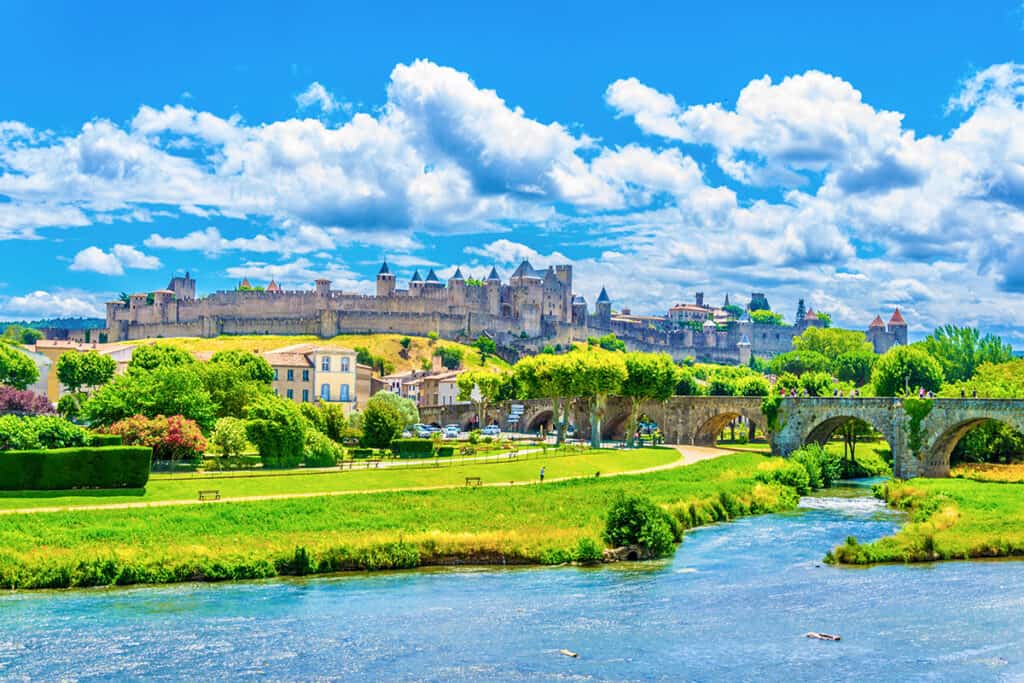
Recommended by Wendy | The Nomadic Vegan
Doesn’t look real, does it? Welcome to Carcassonne.
If you want to be transported into the fairytale dreams of your childhood, there’s no better place than the medieval town of Carcassonne.
Nevertheless, there’s no denying that the fortified city, known as the Cité, is achingly beautiful. Most of it can be explored for free, but do consider paying the 9.50 euros to visit the Château Comtal (Count’s Castle).
Why is it a historical place worth visiting?
This strategic hilltop position has been occupied and fortified as far back as ancient Roman times, but its appearance today is definitely medieval.
Once a stronghold of the Cathars, this castle was captured by the crusaders (and its Cathar inhabitants were persecuted) in 1209.
SECRET TIP- The pointed slate roofs on Carcassonne’s 52 towers are actually part of a major restoration project in the 19th century and are not necessarily historically accurate. So this city is what later generations imagined medieval towns to look like.
Tips for visiting Carcassonne
Opening hours for the ancient Cité are usually 10 am to 6:30 pm (check for special occasions).
Parking is in very short supply around the Cité, so you’re best off coming by public transport or parking in the modern town below and walking the rest of the way.
If you’re touring France in a motorhome, pay close attention to the parking signs or find an aire and walk in. These streets are NARROW, the one-way system is horrendous and you do not want to get lost in your van while trying to navigate them.
Many people visit Carcassonne as a day trip from Toulouse. While you could easily see the town in a few hours, it will probably be quite crowded with other daytrippers. For a more peaceful atmosphere and better photo opportunities, consider staying overnight- there are plenty of hotels, B & Bs and campsites nearby.
Saint-Emilion- a truly historical site in France
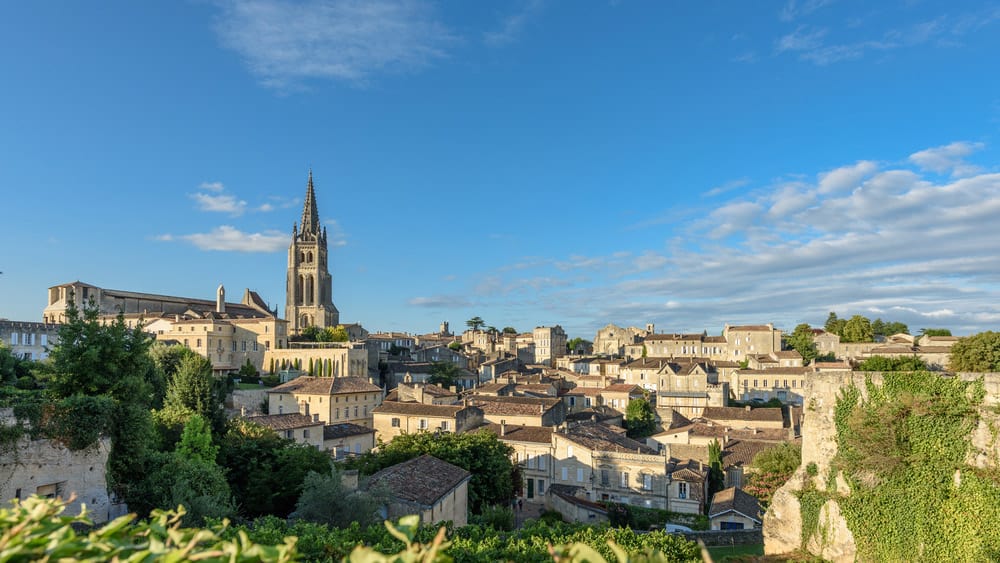
Recommended by Stephanie | History Fangirl
Saint-Émilion is a beautiful village in the Bordeaux region of France, known for the fabulous wine chateaus around the area. While here, you really must go on a chateau tour or two (or four!) so you can sample the wonderful variety of wines produced here.
Plan your chateau visits ahead of time by making appointments with them directly. However, the tourism office can usually help you find places with last minute openings.
Why is Saint Emilion part of French history?
The city is a UNESCO World Heritage Site, which is always a good clue there’s some important history here. The Saint-Emilion area was very important on the pilgrimage route to Santiago de Compostela and many churches, monasteries, and hospices were built there from the 11th century onwards. The location was central to its importance.
You can go on the city’s free tour to learn more about the village’s architecture and history, as well as learning all about Saint Emilion, the monk for whom the town is named.
More tips for visiting Saint Emilion
Make sure to spend at least one meal outside enjoying the French cuisine in one of the town’s beautiful squares. There are also great opportunities for shopping here beyond wine. Never pass up an opportunity to enjoy a French cheese shop!
You can stay here for a few days or you can visit as a day trip from Bordeaux. The trip is an easy one to take by train, and there’s something truly special about walking into the village on foot and exploring.
The Somme- one of the most sobering historical places in France
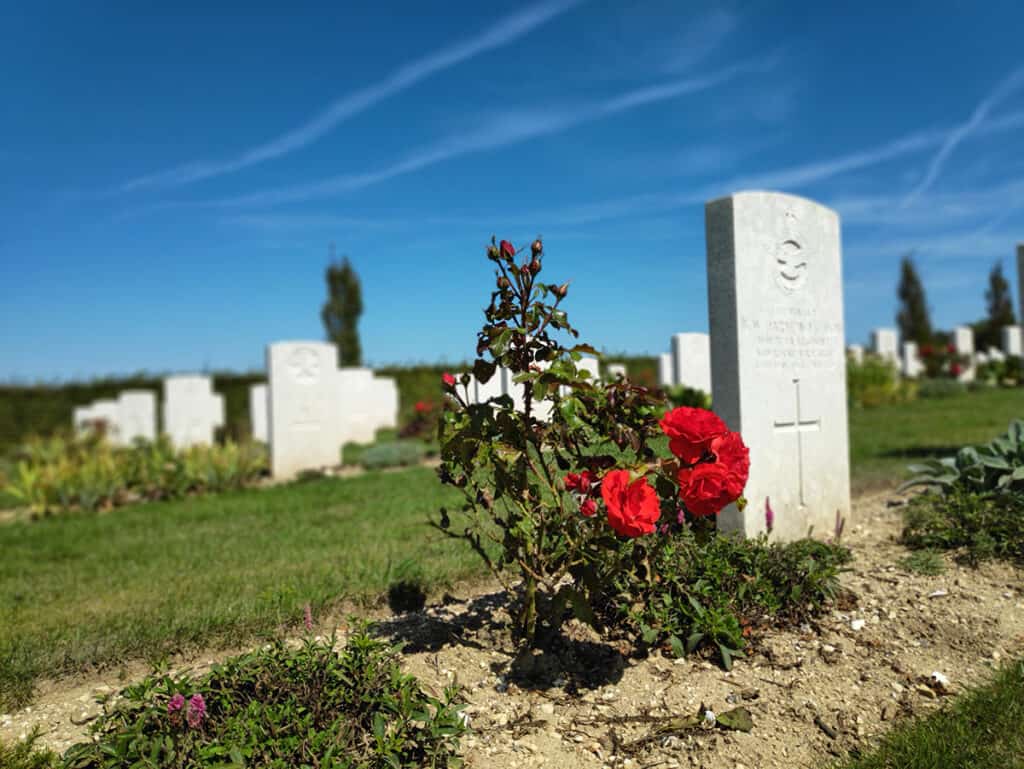
Suggested by Bec | Wyld Family Travel
The Somme is an area in France made up of many small towns and villages. Here is where the Allied troops from countries such as Britain, Australia, Canada, France and New Zealand fought the German Army in World War I.
Why is The Somme a historical place to visit in France?
Named after the river that runs through it, the area is now dotted with small and large cemeteries with the graves of all the soldiers killed in the bloodiest battle of World War one – ‘The Battle of the Somme’.
It is a pilgrimage site for many descendants of the Allies troops to come here to find and honour their ancestors.
How to plan a visit to the Somme
If you are considering a visit to The Somme a good place to start is the visitor centre at Sir John Monash. Here you can research your family and what ties they have with the area. Having a car or camper to drive around the Somme Battlefields is a brilliant idea or you can get a local tour guide to help you get to the gravesites in the area.
The Somme is a place you can visit all year round. The Commonwealth War Graves Commission maintains many of the gravesites and most sites have a car park. There are books at the entrance of the cemeteries that have all the names of the people buried there for you to check as well.
Small towns like Poziers and Fromelles saw much of the Battle of the Somme and have significant memorials there as well as Fricourt and Thiepval.
More tips for visiting the Somme and surrounding historical sites
If you would like to stop for a bite to eat there is Tommy’s Cafe in the town of Poziers. The owner Dominic has a wall covered in names of soldiers that died in the area and would love to meet an ancestor of one of those names. Take the time out to talk to him and you never know what he can tell you about a lost member.
For our Australian friends- Many of the tiny towns have a link to Australia or a town in another country. Villers Brettoneaux is one that has street names of places in Victoria (A State in Australia) and the local primary school has a sign ‘Never forget Australia’. Small museums are located in many of the towns to explain their role in the Western Front Battles.
Another historical war monument well worth a visit is the Menin Gate in Ypres, Belgium. Every night a bugler plays the Last Post at the Menin Gate and it’s one of the most haunting ceremonies we have ever taken part in.
Palace of Versailles- one of the most historic places in France
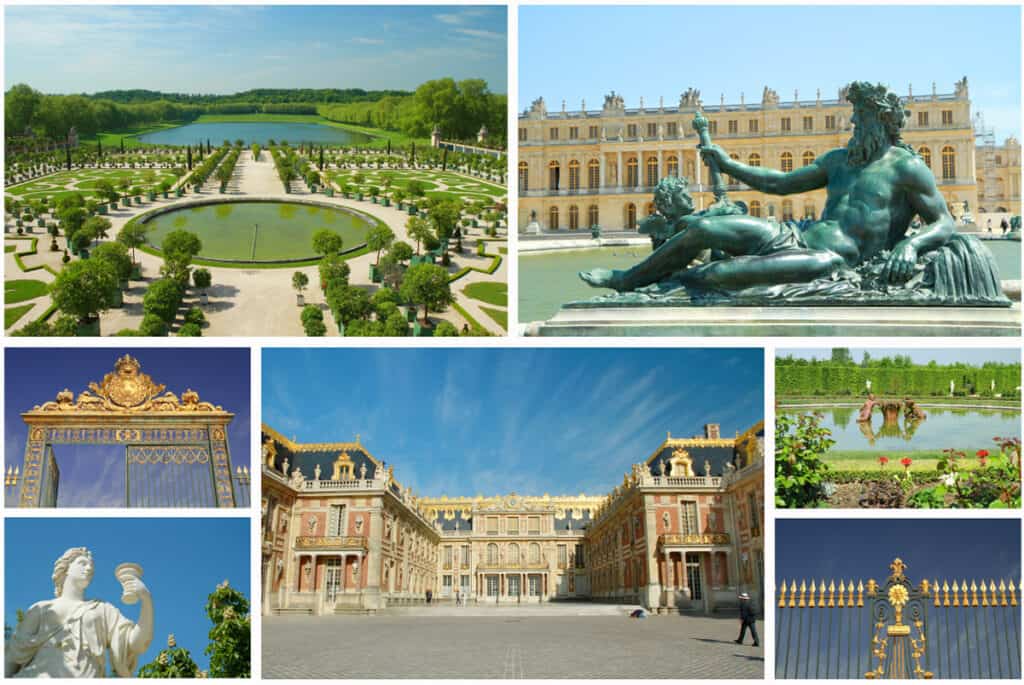
Recommended by Chrysoula | Historic European Castles
Yep- this place was too big to fit into one photo. The sheer OPULENCE of it is incredible.
The Palace of Versailles is a bucket-list must when visiting France as not only is it steeped in history, but the architecture and grounds are truly stunning! The Chateau de Versailles is one of the biggest palaces in the world, with the grounds spanning over 800 hectares and the palace is home to more than 700 rooms!
Highlights of a visit to the Palace of Versailles
While each visitor will find different parts of the palace intriguing, some of the highlights include the Hall of Mirrors, the Royal Apartments, the various salons with exquisite works of art, the sweeping exterior facades, and the manicured gardens and fountains.
Tips for visiting Versailles
You could easily spend half a day (at least) exploring the building and grounds, soaking up the opulence and intricate interiors of the palace.
The Palace of Versailles is open year-round (except Christmas Day and New Year’s Day), from Tuesday-Sunday, 9 am-5.30 pm (check for special occasions.) There are certain parts of the complex that are open earlier or later during the year, such as the gardens which are open longer in summer and The Estate of Trianon and The Coach Gallery, which are open from 12 pm-5.30 pm.
Parking/ travelling to Versailles
If you choose to drive to Versailles, please note that there are several different car parks available to choose from around the palace but these can be very busy in summer. There are parking spaces available in the Place d’Armes car park in front of the palace as well as around the park at the Grand Canal, Petit Trianon, Grand Trianon, and Queen’s Hamlet. The car park at the Neptune Gate is reserved for cars with disabled permits only.
Visitors can easily access the Palace of Versailles from central Paris by taking the train (RER line C) towards Versailles Rive Gauche. From here there are clear signs from the station to the Chateau (approx. 10-15 minutes).
Don’t forget to grab your FREE road trip planner HERE and start creating your perfect trip
Pont du Gard- one of the most historic sites in France!
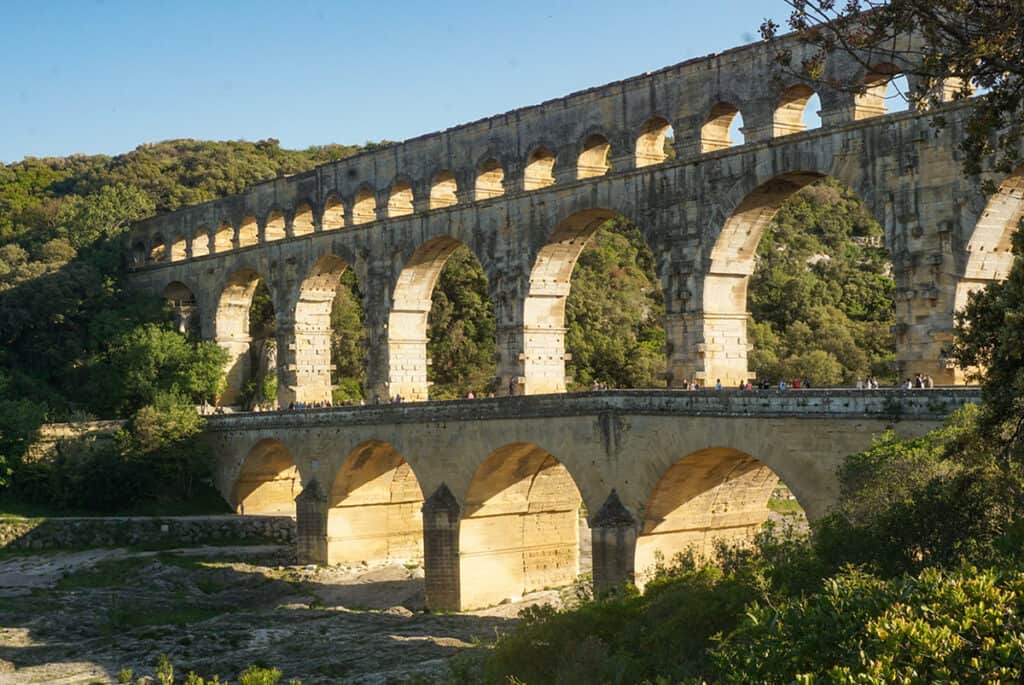
Why should you visit this historical place in France?
How to visit the Pont du Gard by car or camper
The Pont du Gard is an easy day trip from Avignon, Arles or Uzes and there is ample parking in an allocated lot – the cost is included in your entrance ticket.
Make a day of it and pack a picnic lunch to enjoy on the riverbank, or grab a bite to eat in one of the perfectly placed eateries within the complex.
It’s accessible year-round (with reduced hours in the winter months) and there are often public events held within the grounds – when admission is sometimes free for all. Kids go free anytime and will love the interactive museum, and adults will enjoy walking the “Memoires de Garrigue” loop to discover the unique Mediterranean landscapes of this area.
You should allow at least a half-day for visiting, but could easily spend the entire day enjoying the surroundings of the aqueduct, particularly in the summer months when a swim in the gently flowing river will be too tempting to pass up!
Bayonne Cathedral
Stéphanie | Ethno Travels
Bayonne, the town of the famous ham, has many interesting attractions. If you visit the town, don’t miss the magnificent cathedral and its cloister, protected by UNESCO.
Why is Bayonne Catherdral a historic place in France?
Bayonne cathedral was built over 6 centuries, both under Britain and French sovereignty. The cloister was built in the 13th century and a pupil of Viollet le Duc added the 70 meters high spires in the 19th century.
How to plan your visit to Bayonne Cathedral
Start your visit with the cloister you can access by a small door on the left of the main cathedral entrance. It’s one of the largest in France. You will notice the mix of stones and styles with both Romanesque and Gothic elements, the old graves where both religious and rich people were buried. Take the time to shoot pics of the spires and ogives.
At the end of the visit, a door will lead you to the cathedral. Don’t miss the superb stained-glass windows, the 7 chapel’s paintings that were recently renovated, the Canary mahogany pulpit and the coloured keystones, testimonies of the history of the city. Each time I take people there, it always inspires awe and wonder. People didn’t expect to find such a marvel in a so small town.
What else is there to do in Bayonne?
The cathedral is in the heart of Bayonne, close to the Vauban walls, the stilt houses along the rivers leading to the ocean. As the city is the French capital of chocolate, don’t miss the visit of the numerous shops of the traditional chocolate makers. Enjoy the free tasting visit of the Bayonne ham salt factory Ibaialde and eat in Le Pavé close to the cathedral. You can easily spend a whole day visiting the cathedral and the city.
If you want to go further afield, grab a car or camper and head into the French Pyrenees. Make sure you don’t miss a visit to the breathtaking Cirque de Gavarnie– it’s home of the second-highest waterfall in Europe and well worth a visit!
Where to park and how to visit Bayonne Cathedral
Park your car in one of the 1€/5 hours parking. Bayonne is easily accessible by road from Bordeaux (around 2 hours), Lourdes, Pau and Toulouse. There’s also a railway station if you want to park your motorhome in a French aire somewhere and get a train in.
The cathedral is open from 8am to 6:30pm but the cloister timetable can be unpredictable.
Further reading
I’m sure these incredible locations have inspired you to start planning your France trip. Here are some more posts to help you further:
If you want to refer to this post later, pin it to your France Travel board on Pinterest.
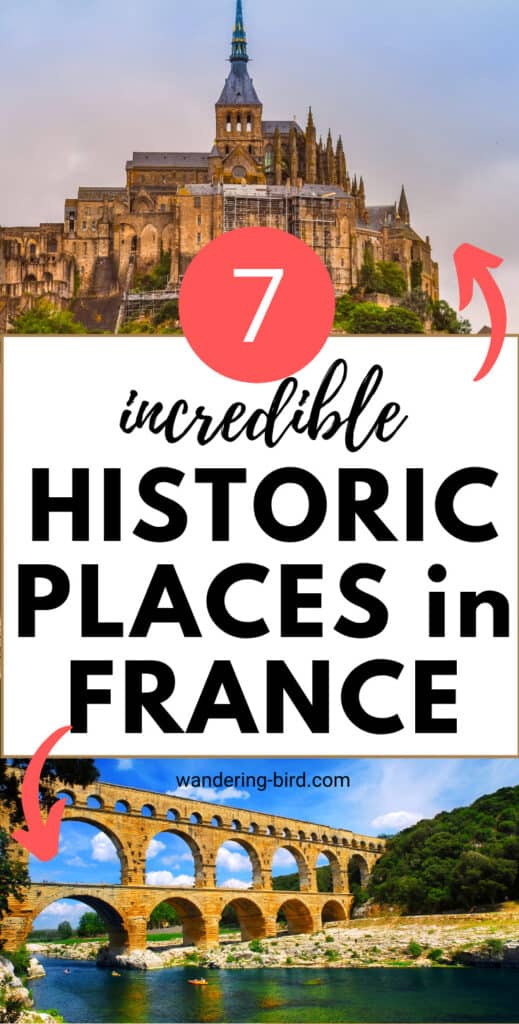


Kat never planned to buy a motorhome. She also never planned to quit her job as an air traffic controller, go touring around Europe in said motorhome, start one of the UK’s largest motorhome travel websites… or get a cocker spaniel.
Find out how she went from stuck in the rat race to being a digital nomad and inspiring thousands of people to have their own epic adventures here.
If you’d like to connect with Kat, send her an email or follow her adventures on social media.


